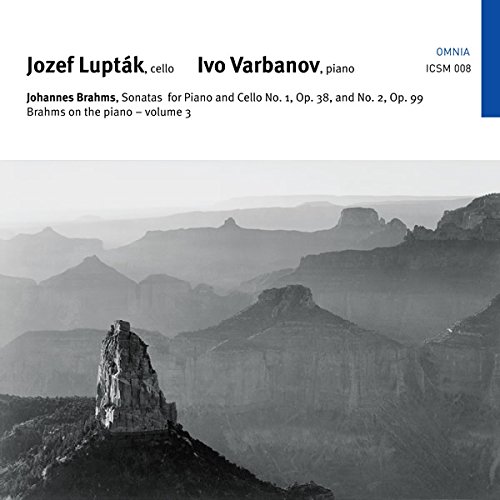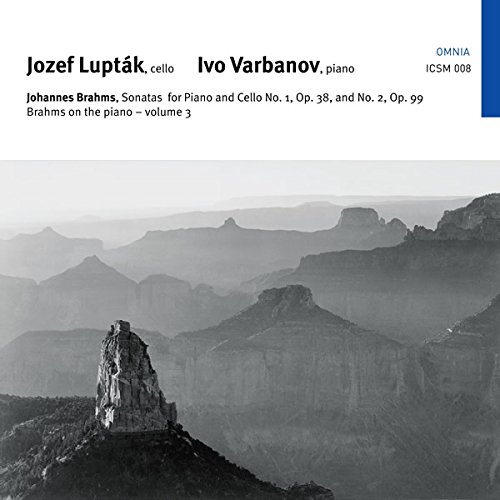BRAHMS Cello Sonatas
View record and artist detailsRecord and Artist Details
Composer or Director: Johannes Brahms
Genre:
Chamber
Label: ICSM Records
Magazine Review Date: 10/2017
Media Format: CD or Download
Media Runtime: 53
Mastering:
DDD
Catalogue Number: ICSM008

Tracks:
| Composition | Artist Credit |
|---|---|
| Sonata for Cello and Piano No. 1 |
Johannes Brahms, Composer
Ivo Varbanov, Piano Johannes Brahms, Composer Jozef Lupták, Cello |
| Sonata for Cello and Piano No. 2 |
Johannes Brahms, Composer
Ivo Varbanov, Piano Johannes Brahms, Composer Jozef Lupták, Cello |
Composer or Director: Johannes Brahms
Genre:
Chamber
Label: Champs Hill
Magazine Review Date: 10/2017
Media Format: CD or Download
Media Runtime: 73
Mastering:
DDD
Catalogue Number: CHRCD134

Tracks:
| Composition | Artist Credit |
|---|---|
| Sonata for Cello and Piano No. 1 |
Johannes Brahms, Composer
Bartholomew LaFollette, Cello Caroline Palmer, Piano Johannes Brahms, Composer |
| (4) Ernste Gesänge, 'Four Serious Songs' |
Johannes Brahms, Composer
Bartholomew LaFollette, Cello Caroline Palmer, Piano Johannes Brahms, Composer |
| (21) Hungarian Dances, Movement: No 20 E minor (arr Piatti) |
Johannes Brahms, Composer
Bartholomew LaFollette, Cello Caroline Palmer, Piano Johannes Brahms, Composer |
| Sonata for Cello and Piano No. 2 |
Johannes Brahms, Composer
Bartholomew LaFollette, Cello Caroline Palmer, Piano Johannes Brahms, Composer |
Author: Andrew Farach-Colton
The F major Second Sonata fares somewhat better. While there’s insufficient vivacity in the opening Allegro vivace or passion in the duo’s lurching rendition of the scherzo-like Allegro passionato, the Adagio is quite affecting. Indeed, Varbanov’s lucid expressivity nearly steals the scene. In the finale, Lupták’s intonation sometimes goes astray, but the air of warm geniality generated by both players is delightful.
In terms of technical finesse and interpretative insight, however, Bartholomew LaFollette and Caroline Palmer’s performances are on another plane entirely. The British-American cellist’s supple phrasing, variegated tone and sensitivity to harmonic incident draw one directly into the music’s interior drama. Note, for example, how LaFollette suggests heightened vulnerability in the exposition repeat of Op 38’s opening movement (at 3'21") and, later, how he and Palmer transform that movement’s coda into a kind of heart-rendingly tender lullaby. In the fugal finale they convey both diligence and ferocity, although they are overly cautious in the Più presto at the work’s end, denying us that last adrenalin rush.
Where the E minor Sonata is darkly lit and melancholic, the F major Sonata is boldly ardent. LaFollette and Palmer revel in the distinction, occasionally sacrificing precision for surging emotion in the more tumultuous passages of the latter. It’s a pity that in the initial phrases of the first movement a few of the cello’s key melodic peaks are inaudible. LaFollette is admirably meticulous in following Brahms’s markings, but here his rendering of the hairpin dynamics is overzealous. Palmer is equally conscientious, mind you, except in the main subject of the third movement, which she plays in a brittle staccato despite Brahms’s request for legato.
Between the two sonatas we’re given extras. Piatti’s arrangement of the 20th Hungarian Dance is played soulfully by LaFollette, with some effectively expressive octave doublings not in the printed score. More impressive still is Daniil Shafran’s transcription of the Vier ernste Gesänge. Whatever is lost in the declamatory fervour of the vocal original is made up for in lyrical generosity here. The opening song is mournful in a way that links Brahms with Mussorgsky, for example, while the central section of the final song offers a most consolatory benediction. Shafran’s own recording of his arrangement is out of print, alas, but his extremely personal, profoundly affecting version of the sonatas has been reissued by Melodiya. LaFollette and Palmer’s interpretations are not quite as individual, perhaps, but will likely have wider appeal.
Discover the world's largest classical music catalogue with Presto Music.

Gramophone Digital Club
- Digital Edition
- Digital Archive
- Reviews Database
- Full website access
From £8.75 / month
Subscribe
Gramophone Full Club
- Print Edition
- Digital Edition
- Digital Archive
- Reviews Database
- Full website access
From £11.00 / month
Subscribe
If you are a library, university or other organisation that would be interested in an institutional subscription to Gramophone please click here for further information.




